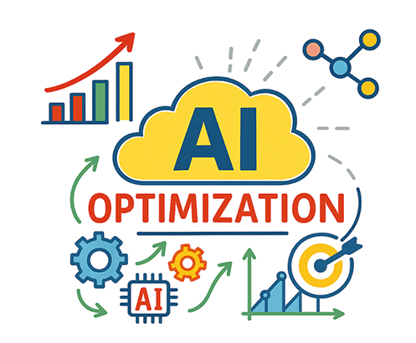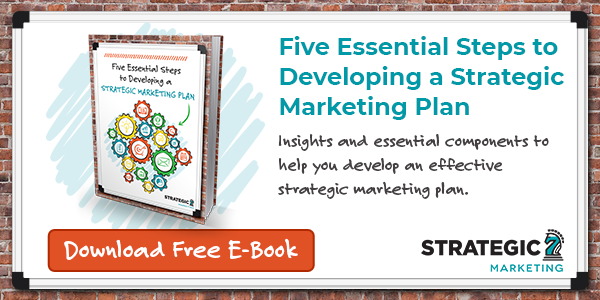To stay visible in the age of AI Overviews and generative search engines, traditional B2B companies and professional services firms must adopt AI Optimization (AIO) strategies. Here's what to do:
- Lead with answers: Use concise, structured, answer-first content formats.
- Implement schema markup: Add structured data (FAQ, Product, Organization) to help AI parse your content.
- Track AI visibility: Use tools like Profound or Scrunch to monitor brand mentions in AI results.
- Build offsite authority: Earn brand mentions on trusted sites and platforms.
- Optimize engagement, not just traffic: Prioritize scroll depth, dwell time and user experience to signal quality.
Generative AI tools favor structured, high-trust, and user-focused content. Brands that adapt will own the AI answer box. Those that don’t will disappear from search visibility.
The Rise of Zero-Click Search and What It Means for Traditional B2B Companies and Professional Services Firms.
Search is changing dramatically for B2B and professional services companies. Traditional SEO tactics are no longer enough in this new landscape. We now have AI-generated answer summaries (AI Overviews) at the top of search results and generative search engines (like Google’s Search Generative Experience and Bing’s AI chat) that give users direct answers. Many users get what they need without clicking through to a website. Recent data shows that nearly 60% of Google searches end with no clicks at all. Google itself is shifting “more toward becoming an answer engine rather than a search engine,” focusing on on-page answers over external links.
As a result, businesses are losing traditional search visibility. Your page might rank, but users often get their answer from an AI summary and never visit your site. This zero-click trend means your content must appear within those AI-driven answers, or your brand risks invisibility. This is where AI Optimization (AIO) comes in. Marketers must quickly adapt their content and strategy for AI-driven search results. Those who don’t adapt will simply vanish from the conversation.
Below are five crucial AIO strategies that professional services firms and B2B companies should implement now to remain visible in search results dominated by AI overviews.
- Create “Answer-First” Content
In the age of AI search, craft your content to answer user questions directly and immediately. Unlike traditional SEO content that might lead up to an answer, AIO content leads with the answer. Start each page with a clear, concise response to the primary question, then provide supporting details. This format aligns with what AI answer engines look for.
Structure your pages so the key information is right at the top. Use simple language and the classic subject-verb-object sentence order. Break down complex explanations into shorter sentences. Organize supporting details under headings or bullet points for easy scanning. Features like bullet point lists, FAQ sections or quick Too Long; Didn’t Read (TL;DR) summaries help both users and AI systems grab the main points at a glance. By front-loading answers and making content skimmable, you increase the chance that generative search engines will feature your text in their instant answers. Studies have found that content with clear sections, bullet points and concise explanations is more likely to be cited by AI systems. In practice, write your content to immediately address the user’s question, then elaborate with details or examples. This “answer-first” approach matches user intent and is favored by AI Overviews.
- Implement Schema Markup Strategically
Schema markup is your secret weapon for signaling content structure to AI. By adding structured data (JSON-LD) like FAQ schema, Review schema, Product schema and Organization schema to your site, you help AI models understand your content’s context and relevance. Even large language models can read and interpret schema: Microsoft’s Bing team confirmed that schema markup helps their LLMs interpret web content for AI search results. In other words, adding schema is like putting up a big signpost for AI: “Here’s what this info means.” Prioritize schema types that deliver answer-ready info. FAQ schema in particular creates ideal question-answer pairs that mirror how users query AI—making it easy for an AI overview to pull your answer. Likewise, Organization schema defines who you are (great for brand recognition in AI results), while Product/Service and Review schema provide rich details that AI can confidently use. As one guide puts it, “Start with FAQ, HowTo, Product, and Organization [schema]. Keep it clean and reflective of the page’s content. LLMs don’t guess – they scan for structure. Structured data helps AI systems understand and cite your content.” By implementing schema thoughtfully across your site, you send strong, machine-readable signals that can boost your AIO visibility in generative search.

- Track AI Visibility and Brand Mentions
It’s critical to measure how often and where your brand appears in AI-generated results—this is the new rank tracking. Traditional SEO tools won’t tell you if ChatGPT or Google’s AI snapshot is mentioning your company. Fortunately, new AIO analytics tools are emerging. Platforms like Profound and Scrunch are designed to monitor your brand’s presence across generative search engines and answer bots, from ChatGPT and Bing to Google’s AI overviews. They can report your “share of voice” in AI answers, track which queries trigger your brand and even analyze the sentiment/context of those mentions. For example, Ramp, a financial operations platform, used Profound’s insights to identify content gaps and rewrite its copy; as a result, Ramp’s visibility in AI-generated answers jumped from 3% of queries to over 22%. This is a striking 7x improvement in AIO presence. The takeaway for marketers: implement tools (e.g., Profound, Scrunch or even new features in familiar tools like UberSuggest) to track your AI visibility metrics. Monitor how often you’re cited or recommended by AI, and what questions you’re missing out on. These insights will guide your content strategy and help you quantify progress in the AI search channel. In a world where AI agents might be your “new customer,” keeping tabs on them is now just as important as tracking human visitors.
- Build Authoritative Mentions Offsite
In AI-driven search, brand authority is the new king. Generative AI models don’t just count backlinks—they learn from the entirety of web content. To get recommended by AI, your brand needs to be mentioned often and in the right context across the web. In other words, AI cares about who talks about you and what they say (sentiment), not just who links to you. Focus on digital PR and thought leadership to earn positive, relevant mentions. For instance, being featured in industry news sites, authoritative blogs, podcasts or Q&A forums can dramatically boost your credibility in the eyes of AI. Studies on AI search ranking factors note that AI systems assess not only the frequency of brand mentions but also their context and the authority of their source. A mention in a respected publication or a meaningful discussion on a niche forum will carry more weight than a dozen low-quality backlinks. So, invest in PR campaigns, guest posting and expert commentary that get your brand name out there alongside strong, relevant content. Encourage organic chatter about your brand on platforms like LinkedIn, Reddit or industry communities—these are places AI “reads” to form its answers. Also, keep an eye on your brand’s online sentiment. Positive mentions (“This firm’s support is excellent…”) can increase trustworthiness scores in AI models, whereas negative contexts might hurt. In practice, this means prioritizing quality over quantity in link-building: a single contextual brand mention in an authoritative source can do more for AIO visibility than dozens of old-school directory links. By building a robust offsite presence and digital footprint, you train AI models to recognize your brand as an authoritative entity—leading to more frequent recommendations in AI overviews.
- Optimize for Engagement Metrics, Not Just Clicks
In a zero-click world, raw traffic is a misleading measure of success. What counts is making the most of the fewer clicks you do get and signaling user satisfaction. This means shifting focus to user engagement metrics: scroll depth, dwell time, bounce rate, and interactive engagement. Search engines (and by extension AI summarizers drawing from search data) use these metrics to gauge content quality. For example, dwell time—how long a visitor stays on your page before returning to results—is believed to be a ranking signal; longer dwell times indicate the page effectively answered the query. Likewise, if users scroll deeply through your content, it suggests high relevance and value. Marketers should optimize content layout and UX for deep engagement. Tactics include breaking up text with subheadings, adding images or videos and providing interactive elements (calculators, assessments, etc.) that keep users on the page. Also, consider deploying tools like Crazy Egg or Hotjar to gather heatmaps and scroll maps—these show you exactly where attention drops off so you can improve page experience. By iterating engagement data, you can increase things like average time on page and reduce bounce rates. Not only will this likely improve your SEO, it will also boost conversion rates. Remember, a decline in traffic doesn’t have to mean a decline in leads or sales. If your content is truly engaging and useful, users who do click through are more qualified and more likely to convert. In fact, many businesses are finding that even as traffic from search dips, their conversions hold steady or rise—because the AI-filtered visitors are further along the decision cycle and more targeted. The bottom line: optimize for user experience and engagement. AIO success isn’t about getting a million fleeting visits but about satisfying the user (or AI) intent so well that it drives the right actions. Google’s own guidance emphasizes “experience” as part of E-E-A-T—Experience, Expertise, Authoritativeness, and Trustworthiness—which includes not just the content itself, but also how users interact with it. By doubling down on engagement, you send positive signals to algorithms and make every click count.
Zero-Click Doesn’t Mean Zero Opportunity—If You’re AIO-Ready
The rise of AI overviews and generative search is a fundamental change to how customers find information. But as we’ve seen, zero-click doesn’t mean zero opportunity. Brands that adapt to AI Optimization can maintain and even grow their business in this new landscape—often with higher-quality leads and conversions, even if raw traffic declines. The five strategies above—from answer-first content and schema to brand mentions and engagement—form a roadmap for staying visible when AI is the gatekeeper. The key is to act now. As one AI marketing platform put it, today’s customer “prefers answers, not links. … Optimizing for keywords and backlinks is no longer enough.” Marketers who move quickly to implement AIO best practices will ensure their companies continue to appear in the conversations and recommendations that matter, across both human and AI touchpoints. Those who stay stuck in old SEO thinking risk fading into obscurity as the search experience evolves.
Don’t wait until your organic traffic plummets further or your competitors establish themselves as the go-to AI answer. Take proactive steps to optimize for AI search today. If you need expert guidance on how to execute these AIO strategies and secure your brand’s place in the AI-driven future of search, contact Strategic 7 Marketing today or visit our AI Optimization Services page to learn more. Our team specializes in helping B2B and professional services firms thrive in this new search landscape. We’ll help you turn AI Overviews from a threat into an opportunity—ensuring your brand is front-and-center when your clients ask the AI engines for answers. Get in touch now, and let’s future-proof your search visibility together.
Key Takeaways
- Traditional SEO is no longer enough—AI is now the gatekeeper to visibility.
- Use answer-first content formats: TL;DRs, bullet points and FAQs help AI quickly surface your answers.
- Add schema markup to give AI clear signals about your content’s structure and meaning.
- Monitor your brand’s presence in AI-generated summaries to measure your visibility and content gaps.
- Offsite brand mentions in credible sources help train AI to trust and cite your company.
- Optimize for engagement metrics like scroll depth and dwell time—these signal content value to AI and humans alike.
- Acting now can give your brand a competitive edge in the evolving search ecosystem.


